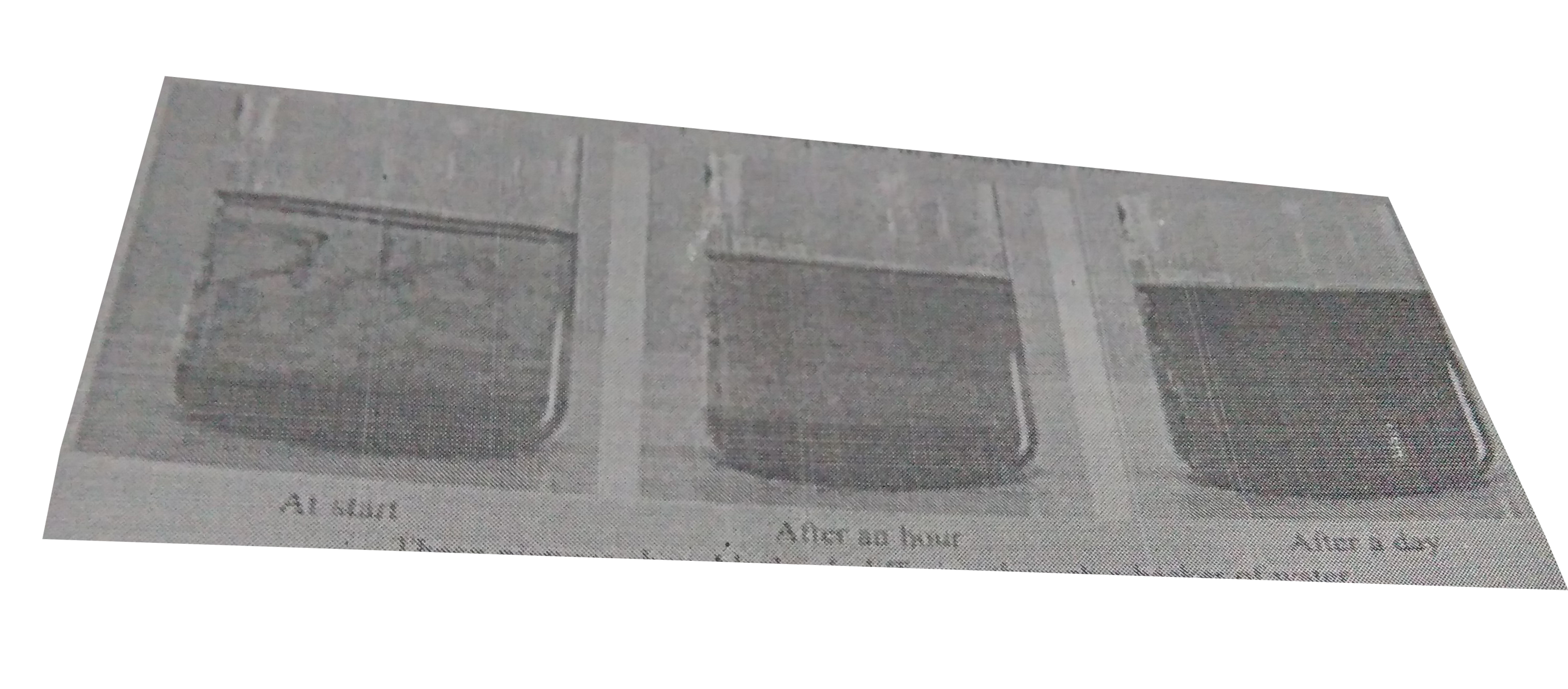Take a thin strip of filter paper.
Draw a line on it using a pencil, approximately 3 cm above the lower edge.
Put a small drop of ink at the centre of the line. Let it dry.
Lower the filter paper into a jar / glass / beaker / test tube containing water so that the drop of ink on the paper is just above the water level, and leave it undisturbed.
Watch carefully, as the water rises up on the filter paper. Record your observations.

What do you observe on the filter paper as the water rises on it ?
As the water rises on the filter paper, the particles of ink also rises.
Topper's Solved these Questions
- BOOK - KUMAR PRAKASHANCHAPTER - IS MATTER AROUND US PUREEXERCISE - INTEXT QUESTIONS AND ANSWERS10videos
IS MATTER AROUND US PURE
- BOOK - KUMAR PRAKASHANCHAPTER - IS MATTER AROUND US PUREEXERCISE - QUESTIONS AND ANSWERS (ANSWER THE FOLLOWING QUESTIONS IN VERY SHORT)31videos
IS MATTER AROUND US PURE
- BOOK - KUMAR PRAKASHANCHAPTER - IS MATTER AROUND US PUREEXERCISE - QUESTIONS BASED ON PRACTICAL SKILLS WITH ANSWERS (ANSWER THE FOLLOWING AS ASKED)8videos
IS MATTER AROUND US PURE
- BOOK - KUMAR PRAKASHANCHAPTER - BIOLOGYEXERCISE - QUESTION BASED ON PRACTICAL SKILLS WITH ANSWERS (SELECT THE APPROPRIATE OPTION AND COMPLETE THE SENTENCE)22videos
BIOLOGY
- BOOK - KUMAR PRAKASHANCHAPTER - MATTER IN OUR SURROUNDINGSEXERCISE - QUESTION BASED ON PRACTICAL SKILLS WITH ANSWER11videos
MATTER IN OUR SURROUNDINGS
Similar Questions
The solid which is left on the filter paper after filtration.…………
View SolutionMarbles of diameter 1.4 cm are dropped into a cylindrical beaker of diameter 7 cm containing some water. Find the number of marbles that should be dropped into the beaker, so that the water level rises by 5.6 cm.
View Solution
Knowledge Check
- Question 1 - Select One
Absorption of water by filter paper is due to
AcohesionBcapillarityCadhesionDelasticity - Question 2 - Select One
A student added the following substances to water kept in four separate beakers. He stirred the mixture well and filtered each one of them through a filter paper. He would obtain a solid residue on the filter paper in the case of :
Aegg albuminBcommon saltCchalk powderDalum - Question 3 - Select One
A small ink dot on a paper is seen through s glass slab of thickness 4cm and refractive index 1.5. The dot appears to be raised by
A1cmB2cmC3cmD1.33cm
Name the process by which a drop of ink spreads in a beaker of water.
 View Solution
View SolutionExplain why filter paper cannot be used to separate colloids?
View SolutionThe particles of a colloid can pass through a filter paper
View SolutionA child wanted to separate the mixture of dyes constituting a sample of ink. He marked a line by the ink on the filter paper and placed the filter paper in a glass containing water as shown in figure. The filter paper was removed when the water moved near the top of the filter paper.
(a) What would you expect to see, if the ink contains three different coloured components?
(b) Name the technique used by the child.
(c) Suggest one more application of this technique.
 View Solution
View SolutionA child wanted to separate the mixture of dyes constituting a sample of ink. He marked a line by the ink on the filter paper and placed the filter paper in a glass containing water as shown in figure. The filter paper was removed when the water moved near the top of the filter paper.
(a) What would you expect to see, if the ink contains three different coloured components?
(b) Name the technique used by the child.
(c) Suggest one more application of this technique.
 View Solution
View Solution

